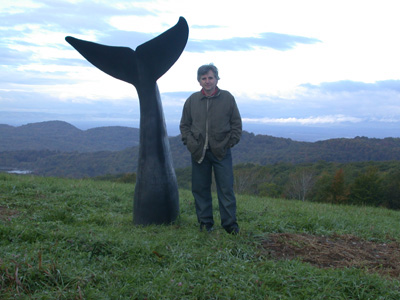What's the process to create a bear from a block of stone?
I usually begin with a small-scale model to show a client what the finished work will look like. From this model I calculate the dimensions needed for the full size piece and search for a [granite] block as close to these proportions as possible.
After choosing and purchasing a block, I hire big diamond saws to make some initial cuts, such as making a flat bottom, cutting the block to the correct proportions and cutting off unnecessary corners, etc. The last few years, I have made use of a special saw called a "contour saw." This is kind of like a big band saw, which can make curved cuts. It is quite expensive, but saves a lot of time in certain situations.
For this project, I drew the contour of the back, neck and head of the large bear (leaving a little extra) and had the large piece under the head and neck sawn out. Of course, the block is still the full thickness, but it gives a good starting point.
From this point, I use my own diamond saws to remove as much of the rough stone as possible. The circular blades are tipped with diamond and can make straight cuts about two to three inches deep. By making several parallel cuts about two inches apart, the stone can than be broken from the side with a thick flat chisel. This is the technique I use for the "roughing out" process. Lots of straight cuts can begin to describe a curved surface.
I am nearly finished with this part at this point and soon I will begin using my pneumatic hammers – or air hammer -- and chisels. At that point I will be between 1/2" to 1" from the final surface. This is a time-consuming process. Granite is very hard and it's necessary to pulverize the surface with four and nine pointed chisels until you are very close to the final form. Then you can use various sizes of flat chisels that fit into these air hammers, which are like miniature jack hammers.
How long does the process take, start to finish?
If I include the preliminary model-making, this project should take about 6 months -- I hope.
What's your favorite part of the sculpting process?
I enjoy all phases of the project, but I guess I especially like it when I reach the point where everything has come together and it is just the final surface that needs work.
For a long time, it seems as though things are not quite developing quickly enough and you wonder if you will ever reach that point. Luckily, eventually it always does.
What's your attraction to nature and natural forms? Why is it important to you to create them?
I have been attracted to nature and natural forms from childhood. I was always fascinated with snakes, frogs, turtles and other creatures for as long as I can remember and often collected them as pets.
My first stone carving was a frog (as a student at Phillips Exeter Academy) and first bronze a mother and baby koala bear. I continued to study art and art history at Oberlin College, where I was encouraged to experiment with more "contemporary" ideas and materials. During that time I worked with foam rubber and abstract forms. While it was enjoyable, as soon as I left I returned to the natural forms and materials to which I was always drawn.
At this point I see nature as my "religion."
You often place creatures outside of their natural habitat -- like your hippos at the edge of Vermont lake, or whale tails waving from a hillside. What do you see as the significance of a polar bear in downtown Andover?

I guess I hope by placing creatures outside of their natural habitat that it might cause people to think about the fact that our world is very small. That what we do in Andover or anywhere else has an effect on creatures all over the world. The polar bear has become the "poster child" for global warming. Hopefully, the sculpture will serve as a focal point for discussions about man's effect on the environment.
In 2000, I was commissioned to make a sculpture of the extinct Great Auk. This is an example of what can happen when we do not exercise good stewardship of our environment. I hope the polar bear will not suffer the same fate. I'd like to think that my work might have some small beneficial effect on their survival. I think children are the answer to turning things around.
What's it like being a professional sculptor? Is it as awesome as it seems it would be?
It is awesome to be a professional sculptor, but it is not without its down side. It is wonderful to wake up and look forward to working, even though it is physically demanding. To get paid for creating my own designs in stone and bronze is a dream.
However, one never knows where the next job will come from or how long it may take to find one. This economic insecurity is the most difficult part. I've learned to keep working at finding the next commission while I'm working on the current one and to try not to worry too much about it. So far, things have worked out quite nicely.
When a piece is finished and leaves your studio, do you ever miss it or feel a sense of sadness of "letting it go"?
I do miss having a sculpture around my studio after it leaves, especially after working on it for many months. The good thing is that I'm fortunate to have sculptures that I can visit in some beautiful places. Now I'll be forever returning to Andover, something I never imagined as a graduate of Exeter!
